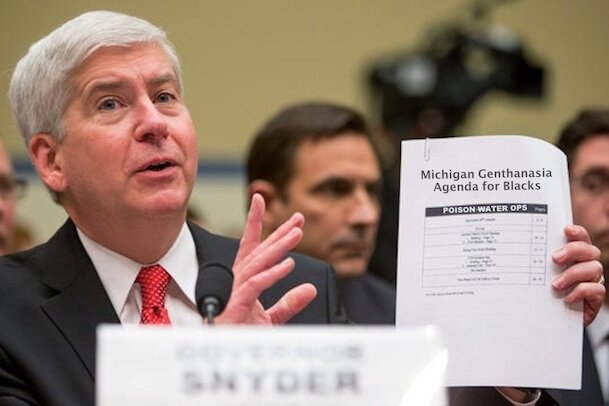Ct says No Basis to Dismiss Racist Suspect Governor from Flint Case: Snyder Oversaw the Switch to Contaminated Water and then Refused to Switch Back, Knowing [mostly Black] People were Being Poisoned
/The Sixth Circuit denied immunity to Michigan government defendants, including former Governor Rick Snyder, in actions stemming from the Flint water crisis based on the court’s previous findings that the officials played direct roles in creating the crisis. The order states:
“This is an appeal from one of the many strands of the Flint Water Crisis litigation. The City of Flint and City and State officials (collectively, “Defendants- Appellants”) allegedly caused, sustained, and covered up the poisoning of the people of Flint.
Defendants-Appellants in this case are largely the same as those that were parties in In re Flint Water Cases (Waid v. Snyder), 960 F.3d 303 (6th Cir. 2020).3 There are no new Defendants-Appellants in this case, the claims at issue are the same, and we again take their appeal at the motion-to-dismiss stage.4 In Waid, we decided that the same City and State officials who are Defendants-Appellants in this case plausibly violated plaintiffs’ substantive due process right to bodily integrity and are not entitled to qualified immunity. Id. at 311. We additionally rejected the City of Flint’s and Governor Whitmer’s arguments that the Eleventh Amendment requires their dismissal from the case.”
The order explains in respone to the concurrence;
“The plaintiffs in Waid alleged that Snyder personally helped coordinate the City of Flint’s switch from clean Detroit Water and Sewerage Department (“DWSD”) water to contaminated Flint River water. Waid, 960 F.3d at 330. Plaintiffs-Appellees additionally allege in this case that Snyder not only knew that the Flint River would serve as an interim water source, but that he knew that there were no plans to update the water plant so that it could treat the water properly before making the switch. R. 185-2 (Am. Master Compl. at 35–36, ¶ 109) (Page ID #5076–77). Moreover, Snyder’s staff were told that “the ‘expedited timeframe’ for switching to Flint River water ‘is less than ideal and could lead to some big potential disasters down the road.’” Waid, 960 F.3d at 314 (internal quotation omitted).
Soon after the switch went into effect, General Motors cut off the Flint River water supply to its engine plant because the water’s chloride levels were so dangerously high that it would corrode the machinery. Id. at 315–16. In response, a member of Snyder’s executive staff “sent an email to the full team about comments in the media about Flint residents being treated as “lab rats,” and fretting that it might come out that the chemical composition of the water “exceeded health-based water quality standards.” Id. at 316 (internal quotation omitted). To prevent the crisis from snowballing, the executive staff member recommended that the Governor’s office ask the Emergency Manager for the City of Flint to switch Flint back to its prior source of clean water, the DWSD. Id. Snyder’s legal counsel agreed that the Flint River water issues were “‘downright scary’ and “advised that, ‘[t]hey should try to get back on the [DWSD] system as a stopgap ASAP before this thing gets too far out of control.’” Id. (internal quotation omitted).
Yet, Snyder did not try to switch Flint back to clean water, or to mitigate the crisis with protective equipment, or to acknowledge the dangers of the water contamination—even after his own chief of staff told him that “[t]he water issue continues to be a danger flag.” See id. at 318 (internal quotation omitted). Snyder’s office, instead, coordinated with the MDEQ Director of Communications to create political cover for Snyder’s administration. See id. Snyder’s office also managed to supply water coolers for State buildings, while refusing to distribute water filters to the people of Flint. See id. at 330. From these allegations, it is hard to imagine that Snyder was kept in the dark about the cause and extent of the crisis, and we do not hesitate to conclude that Snyder’s alleged personal actions demonstrated deliberate indifference.
But the concurrence’s point is not really about the plausibility of the pleadings or whether Snyder’s conduct shocks the conscience. The concurrence’s real issue with Waid is that we refused to dismiss a high-ranking government official from the litigation. To escape the Waid plaintiffs’ and Plaintiffs-Appellees’ extensive and personal allegations against former Governor Snyder, the concurrence peddles a new appendage to qualified-immunity doctrine that effectively would grant high-ranking officials absolute immunity regardless of the allegations. Snyder, in the concurrence’s view, simply is too high-up to be accountable. Perhaps that would be the case for a different governor in a different set of circumstances. Perhaps that would be the winning argument had the crisis in Flint not been under the public eye and had it not been orchestrated and debated at the highest levels of state government. But on these facts, Snyder is alleged to have coordinated the switch to Flint River water knowing that the water would not be treated for contamination. Snyder is alleged to have refused to switch Flint back to clean water, knowing that the people of Flint were being poisoned. Snyder is alleged to have hidden the full extent of the dangers and to have failed to take remedial actions. On these facts, Snyder is named to defend his own actions, not those of his subordinates, and there is no basis for dismissing him from this case. Thus, although we fail to see why saying so is relevant to the task at hand, we stand by our decision in Waid. [MORE]































































































































































































































































































